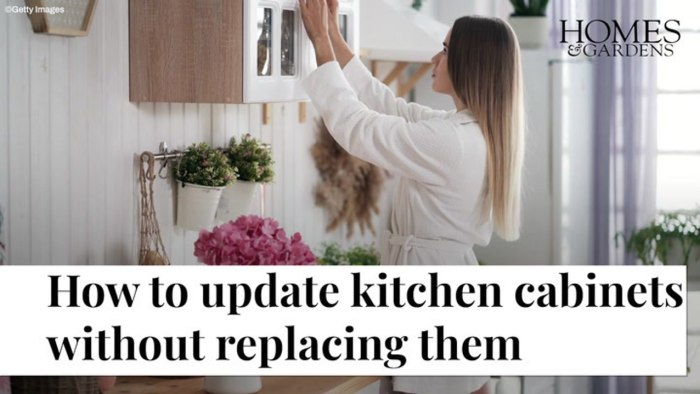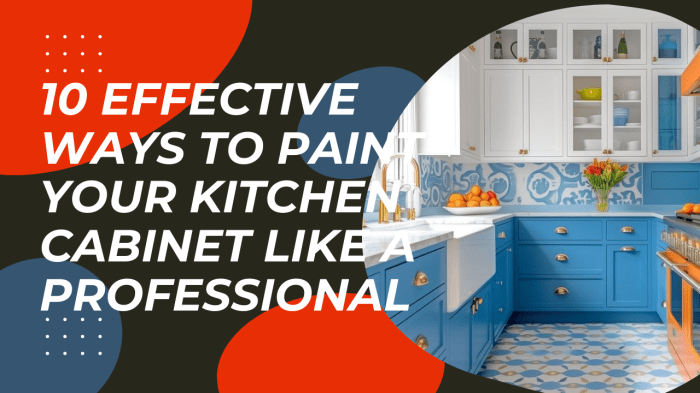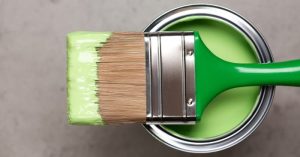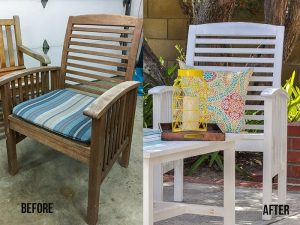
Embark on a journey to flawless kitchen cabinets with our expert tips on achieving a streak-free paint job. From surface preparation to color choices, we’ve got you covered for a professional finish that shines.
Learn the secrets to transforming your kitchen with a fresh coat of paint without the hassle of streaks.
Tips for Painting Kitchen Cabinets Without Streaks
When painting kitchen cabinets, achieving a smooth and streak-free finish is essential for a professional look. This can be accomplished through proper surface preparation, using high-quality paint and tools, and applying thin, even coats of paint.
Surface Preparation
Before painting kitchen cabinets, it is crucial to clean and sand the surfaces properly. This helps the paint adhere better and minimizes the chances of streaks and imperfections.
Smooth and Streak-Free Application Techniques
- Use a quality paintbrush or a paint sprayer for a smooth application.
- Work in small sections and maintain a wet edge to avoid visible brush marks.
- Apply the paint in the direction of the wood grain to prevent streaks.
High-Quality Paint and Tools
Investing in high-quality paint and tools can make a significant difference in the final result. Quality paint tends to level better and provides a more durable finish, while good tools help in achieving a professional look without streaks.
Thin, Even Coats of Paint
Applying thin, even coats of paint is key to preventing streaks and achieving a flawless finish. Multiple thin coats are better than one thick coat, as they dry faster and are less likely to show streaks or brush marks.
Painting
When it comes to painting kitchen cabinets, choosing the right type of paint finish and color is crucial to achieving a professional and streak-free look.
Types of Paint Finishes
- Satin Finish: Offers a smooth, velvety appearance and is easy to clean, making it a popular choice for kitchen cabinets.
- Semi-Gloss Finish: Provides a shiny and durable surface that is resistant to moisture and stains, ideal for high-traffic areas like the kitchen.
- High-Gloss Finish: Creates a sleek and modern look but can highlight imperfections, so proper preparation is essential.
Color Choices for Kitchen Cabinets
- White: Reflects light and makes the kitchen feel brighter and more spacious.
- Neutral Tones: Beige, gray, or greige colors offer a timeless and versatile appeal.
- Blue or Green: Adds a pop of color while still maintaining a classic look.
Impact of Natural Light
Natural light can significantly affect how paint colors appear in the kitchen. Colors may look different depending on the intensity and direction of sunlight, so it’s essential to test samples in various lighting conditions before making a final decision.
Selecting the Right Tools
- Paintbrushes: Use high-quality synthetic brushes for a smooth finish, and choose the appropriate size based on the cabinet’s surface area.
- Rollers: Opt for foam rollers for a streak-free application, especially for larger cabinet surfaces.
Performing Arts

When it comes to painting kitchen cabinets, understanding color theory and the role of lighting can significantly impact the final result. Here, we will delve into how these elements can enhance the visual appeal of your cabinets and kitchen space.
Color Theory in Painting Kitchen Cabinets
Color theory plays a crucial role in painting kitchen cabinets without streaks. Consider the following tips:
- Choose colors that complement each other to create a cohesive look.
- Use the color wheel to select harmonious color schemes, such as complementary or analogous colors.
- Consider the existing colors in your kitchen and select cabinet colors that will blend well with the overall palette.
Role of Lighting in Cabinet Painting
Lighting can significantly impact how your painted cabinets appear. Follow these tips to make the most of lighting:
- Opt for natural light whenever possible to showcase the true colors of your cabinets.
- Install under cabinet lighting to highlight the details and colors of the cabinets.
- Avoid harsh lighting that can create unwanted shadows and alter the perceived color of the cabinets.
Creating a Harmonious Color Scheme
Creating a harmonious color scheme in the kitchen through cabinet painting can elevate the overall aesthetic. Consider the following suggestions:
- Stick to a maximum of three colors to avoid overwhelming the space.
- Utilize different finishes (e.g., matte, gloss) to add depth and visual interest.
- Experiment with color blocking or patterns to infuse creativity into the design.
Incorporating Artistic Elements into Cabinet Painting
To add a unique touch to your kitchen cabinets, consider incorporating artistic elements into the painting process. Here are some ideas:
- Hand-paint intricate designs or patterns on cabinet doors for a personalized look.
- Use stencils to create geometric shapes or motifs that reflect your style.
- Add metallic accents or decorative hardware to enhance the artistic appeal of the cabinets.
Philosophy

Freshly painted kitchen cabinets have the transformative power to completely revitalize a space, breathing new life and energy into the heart of the home. The act of painting cabinets goes beyond mere aesthetics; it signifies a renewal, a fresh start, and a chance to redefine the ambiance of the kitchen.
Color Psychology and Mood
Colors have a profound psychological impact on our mood and the overall ambiance of a room, including the kitchen. Choosing the right hue for your cabinets can evoke different emotions and set the tone for the space. For example, calming blues can create a serene atmosphere, while vibrant yellows can infuse energy and warmth into the kitchen.
Art of Transformation
Painting kitchen cabinets is not just a mundane task; it is an art form that requires careful consideration and skill. The process of transforming a space through painting involves a deep understanding of color theory, design principles, and a keen eye for detail. It is a creative endeavor that allows homeowners to express their personal style and breathe new life into their surroundings.
Mindfulness in Painting
Engaging in the process of painting kitchen cabinets can be a meditative experience, requiring focus, patience, and attention to detail. Practicing mindfulness while painting allows individuals to fully immerse themselves in the task at hand, fostering a sense of presence and tranquility. It is an opportunity to appreciate the beauty of the moment and savor the act of creating something new.
Photography
Capturing the beauty of newly painted kitchen cabinets through photography is essential to showcase the transformation. Proper techniques, staging, lighting, and editing can significantly enhance the visual appeal of cabinet painting photographs.
Techniques for Capturing Beauty
- Use a high-quality camera with good resolution to capture the details and colors accurately.
- Avoid harsh lighting that can create glare or shadows on the cabinets.
- Experiment with different angles to find the most flattering shots of the painted cabinets.
Staging Tips
- Clean and declutter the kitchen before taking photographs to ensure the cabinets are the main focus.
- Add decorative elements like fresh flowers or stylish kitchenware to enhance the overall look.
- Consider the background and surroundings to create a cohesive and appealing composition.
Lighting Strategies
- Utilize natural light whenever possible for a soft and flattering look on the cabinets.
- Use artificial lighting sources strategically to highlight specific areas of the cabinets.
- Avoid direct flash that can create harsh shadows and wash out the colors of the cabinets.
Editing Techniques
- Adjust the brightness, contrast, and saturation levels to enhance the colors and details of the painted cabinets.
- Remove any distracting elements or imperfections in the background using editing software.
- Consider adding filters or effects to create a unique and visually appealing style for the cabinet painting photographs.
Short Fiction
In a small town nestled among rolling hills, there lived a young artist named Lily. She spent her days working odd jobs to make ends meet, but her true passion lay in painting. One day, while helping a neighbor renovate their kitchen, Lily found herself mesmerized by the simple act of painting cabinets.As she carefully applied each stroke of paint, Lily felt a sense of calm wash over her.
The repetitive motion of the brush against the wood was almost meditative, allowing her mind to wander and her creativity to flow freely. In that moment, she found solace in the act of transforming something ordinary into a work of art.Inspired by this newfound sense of peace, Lily decided to start her own business painting kitchen cabinets. She poured her heart and soul into each project, infusing every cabinet with a touch of her artistic flair.
Through her work, she brought new life to old, worn-out cabinets, turning them into pieces that sparkled with renewed beauty.
The Transformation
Lily’s business quickly gained popularity in the town, with homeowners seeking her out for her unique artistic touch. As she worked on each cabinet, she found herself not only transforming the physical appearance of the furniture but also the lives of those who owned them.The simple act of painting cabinets became a metaphor for transformation and renewal in Lily’s eyes.
She saw how a fresh coat of paint could breathe new life into a tired kitchen, how a splash of color could brighten even the darkest of spaces. Through her art, she inspired others to embrace change and see the beauty in the ordinary.In the end, Lily’s passion for painting cabinets not only brought her success but also a sense of fulfillment and purpose.
She realized that creativity knows no bounds and that even the simplest of acts can lead to profound transformation. And so, she continued to paint, one cabinet at a time, leaving a trail of beauty and inspiration in her wake.
Visual Graphic Arts
When it comes to painting kitchen cabinets without streaks, the use of graphic design principles can be incredibly helpful in planning and visualizing the project. By incorporating concepts like visual balance and composition, you can ensure that your cabinets look cohesive and aesthetically pleasing.
Using Graphic Design Principles
- Consider the color scheme: Think about how different colors will work together on your cabinets. Use color theory to create a harmonious palette that complements your kitchen’s overall design.
- Pay attention to contrast: Utilize light and dark shades to create visual interest and depth on your cabinets. Contrast can help highlight certain areas or features.
- Think about texture: Experiment with different finishes and techniques to add texture to your cabinets. This can create a tactile element that enhances the visual appeal.
Creating Digital Mockups
- Use graphic design software: Programs like Adobe Photoshop or Canva can help you create digital mockups of your painted cabinets. This allows you to experiment with different colors and finishes before committing to a final look.
- Take measurements: Ensure that your digital mockups accurately represent the size and layout of your kitchen cabinets. This will help you visualize how the new paint job will look in your space.
- Share with others: Share your digital mockups with friends, family, or professionals for feedback. This can help you make informed decisions and refine your cabinet painting ideas.
Visualization with Graphic Arts Tools
- Utilize online tools: Websites like Pinterest or Houzz offer inspiration and ideas for cabinet painting projects. Create mood boards or visual collages to gather ideas and refine your vision.
- Try virtual room planners: Some home improvement websites offer virtual room planning tools that allow you to upload a photo of your kitchen and test different paint colors on your cabinets.
- Experiment with filters: Use photo editing apps to apply different filters to images of your cabinets. This can give you a sense of how different colors and finishes will look in your space.
Elevate your kitchen’s aesthetic with our tips for painting cabinets without streaks. Say goodbye to uneven finishes and hello to a smooth, professional look that will impress for years to come.
Essential Questionnaire
How important is surface preparation before painting kitchen cabinets?
Surface preparation is crucial as it ensures proper adhesion of the paint and helps in achieving a smooth finish without streaks.
What types of paint finishes are suitable for kitchen cabinets?
Paint finishes like satin or semi-gloss are popular choices for kitchen cabinets due to their durability and ease of cleaning.
How can I prevent streaks while painting kitchen cabinets?
Applying thin, even coats of paint using high-quality tools and brushes can help prevent streaks and ensure a professional finish.







